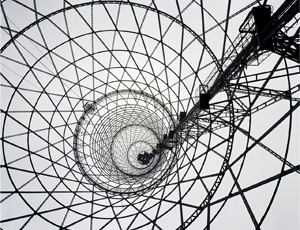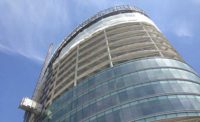

Internationally renowned structural engineers and architects are calling on Russian President Vladimir Putin to save from demolition Moscow’s iconic Shukhov radio tower. Designed by Vladimir Grigorievich Shukhov, who is credited with developing the hyperbolic-tower concept, the 92-year-old steelwork structure is “one of the superlative engineering feats of the twentieth century,” the engineers and architects assert in an open letter to the Russian strongman.
Completed in 1922, the single-skin lattice tower rises 148.5 meters from its 40-m-dia circular foundation; it is topped by a flagpole that raises the height to 160 m. Comprising straight steelwork beams, the tower was assembled in six sections at ground level and erected in the same way a telescope is extended. No cranes were used.
The tower “is acknowledged as one of the most beautiful and prominent achievements of engineering thought,” according to the Shukhov Tower Foundation, Moscow, established to promote scientific and engineering achievements. However, the tower has fallen into disrepair and is scheduled to be dismantled.
“Dismantling the tower and storing its components in order to rebuild it later, even if it were possible to do so, would be extremely hazardous,” warn signatories of the letter to Putin. The signers include structural engineers Bill Baker, a partner in Skidmore Owings Merill LLP, Chicago, and Paris-based Marc Mimram. Among the architectural signatories are Frank Gehry, Tadao Ando and Rem Koolhaas.
Born in 1853, Shukhov started as an early oil-industry engineer and innovator before moving into other sectors, including bridge design, according to the foundation, now headed by his great-grandson Vladimir Fyodorovich Shukhov. Shukhov also designed lightweight roof structures, including, in the 1890s, the covering of Moscow’s GUM store.




Post a comment to this article
Report Abusive Comment